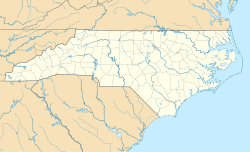Dr. H. D. Lucas House | |
| Location | Center St., Black Creek, North Carolina |
|---|---|
| Coordinates | 35°38′12″N77°56′4″W / 35.63667°N 77.93444°W |
| Area | Less than one acre |
| Built | c. 1850, c. 1885 |
| Architectural style | Greek Revival, Victorian Cottage |
| MPS | Wilson MRA |
| NRHP reference No. | 86000771 [1] |
| Added to NRHP | February 13, 1986 |
Dr. H. D. Lucas House was a historic home located at Black Creek, Wilson County, North Carolina. It consisted of two sections: a one-story Greek Revival style doctor's office built about 1850, and a late-19th century, Victorian cottage dated to the early 1880s, which served as Dr. Lucas' residence. The cottage was a one-story, three-bay, single-pile frame dwelling with a steeply pitched gable roof. [2] The house has been demolished.
It was listed on the National Register of Historic Places in 1986. [1]



